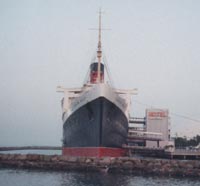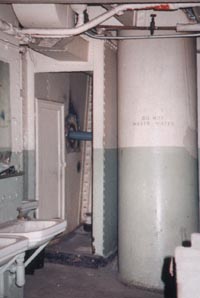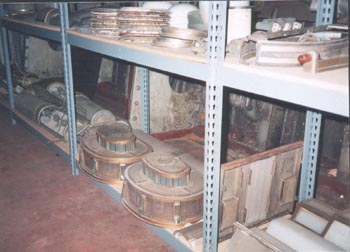

In the late 1990s the operator of the Queen Mary, the RMS Foundation/Q.S.D.I., began a professional historic-preservation planning effort with initial consultancy by Dr. Knox Mellon, once the chief preservation officer of the State of California. A three page set of preliminary guidelines was published at that time. While the professional level effort has unfortunately not progressed beyond these guidelines, we understand that a group of local volunteers does meet periodically to discuss collections-policies.
In support of the much needed professional level effort we offer our thoughts on the preservation of the ship and its cultural and educational mission. Whether the ship is operated as a tax-exempt "for public benefit" entity as it is now or as a commercial - "for profit" entity as it has been in the past, we believe that fulfilling this public service mission elevates its stature to that of a world-class cultural venue as well as encourages its commercial operations.
This mission should include:
Museums and cultural institution rely on the support of volunteers to help them fulfill their public mission. Even large, well-endowed institutions such as the Metropolitan Museum of Art in New York City and the J.Paul Getty Museum in Los Angeles (with a multi-billion dollar endowment) use armies of volunteers in various areas of their operations and curatorial efforts. They are not simply a means to reduce labor costs, but are an important part of the community outreach and educational efforts of the institutions. Two noteworthy local examples are the Aquarium of the Pacific and Rancho Los Alamitos.
First conceived in 1994, construction beginning in late1996 and opening to the public in mid 1998, the Aquarium of the Pacific already boasts a core volunteer group of over 600 citizens. In its first year of operation this has translated into over 1,800,000 paying visitors. Management is trying to increase the core volunteer group to 800. They are organized into a series of service areas.
The Rancho Los Alamitos has a core group of almost 200 volunteers, organized into eight functional categories that include house keepers, grounds keepers, animal tenders, fund raisers and administrative staff.
The Queen Mary has benefited from a core group of volunteers in the short-wave radio room operation. We believe that a fully developed program of volunteers for the Queen Mary might also include:
Tour docents – both for the guided tours and self guided "stations." For the self guided areas of the ship that might be viewed between the guided tours, we have proposed restoration of the kennel, first class gymnasium, navigation officer’s quarters, wheelhouse.
Museum shop sales docents – assisting in the museum shops in restored areas such as our proposed bookstore/gift shop in the former first class library, fine art and furnishing reproduction shop in the former drawing room, period toy reproduction shop in the former first class playroom.
 Restoration workers – particularly in areas where attention to detail
and hard work are more essential than the highest skills levels of
craftsmanship. Examples include crew areas in the bow of the ship (photo - left)
that need to
be properly prepped for painting, mail handling areas on B deck forward - where
recently applied floor to ceiling black paint needs to be entirely removed; the
working alleys and engineering spaces.
Restoration workers – particularly in areas where attention to detail
and hard work are more essential than the highest skills levels of
craftsmanship. Examples include crew areas in the bow of the ship (photo - left)
that need to
be properly prepped for painting, mail handling areas on B deck forward - where
recently applied floor to ceiling black paint needs to be entirely removed; the
working alleys and engineering spaces.
Archive docents – maintaining and cataloging the hundreds of thousands of original artifacts and paper archival items on the design, construction and use of the Queen Mary. Responding to inquiries and maintaining a reading room for scholarly research takes staff.
Housekeeping docents for exhibit areas - Silver that is displayed needs polishing to look maintained, crystal and china needs to be carefully washed periodically to look fresh. Fresh flowers and other decorations add a festive touch – particularly around the holiday seasons. Wouldn’t the Queen Mary look wonderful if here grand interiors were decorated for the Christmas season the way Colonial Williamsburg is every year!
Fund raising volunteers– maintaining mailing lists, sending mailings to thousands of contributors and assisting in fund raising events is another area where non-profit institutions routinely draw on the support of volunteers.
Community outreach program volunteers – supporting the use of the third class public rooms by various local historical and cultural institutions for meetings - with scheduling support, preparation and clean up; assisting in developing and running a sleepover program for school children in the former crew areas of the ship and running a school children tour program; scheduling concerts and other live entertainment by local performing groups in various areas of the ship -- are just a very few ideas that come to mind.

Part of the Queen Mary's collection of light fittings in storage
The Queen Mary is an actively used historic property much like the White House. While it no longer transverses the North Atlantic, it still provides hospitality services for thousands of visitors per week. The challenge is to create and maintain an ambience that both capitalizes on and responsibly utilizes its great collection and interiors, while protecting and preserving them for future generations.

The Red Room in the White House
What are the procedures the White House uses to maintain and preserve its historic furnishings and artifact collection in use daily? These include:
The implications for the Queen Mary include bringing professional curatorial standards to the management and maintenance of the archives and the historic artifact collection.
Better use of the collection requires rethinking of the operational plan imposed on the ship in the early 1970’s. (See the Alternative Visions series of essays for more detailed views on this matter.)
In the Queen Mary came thousands of documents and blueprints and photographs relating to the ship’s design, construction and operation. These materials were organized and supplemented by a research team working for the Queen Mary Department of the City of Long Beach. An extensive "vertical file" of clipped material was organized by topic alphabetically. An extensive collection of photographs of both exteriors and interiors most of which were taken by Stewart Bale was collected and organized. New negatives were made for many of these photographs.
This archive is the property of the City of Long Beach. At this point it may be the most comprehensive in the world relating to the Queen Mary or any other of the great ocean liners of the twentieth century.
The Queen Mary is not only a world famous "icon" but is also a state tidelands property and on the National Register of Historic Places. We believe that because of the important role the ship played in World War II and mid-twentieth century international affairs it should be designated both an official World War II memorial and world cultural site. It is appropriate then that some of the facilities and profits from the operation be devoted to her public service role.
We suggest:
We salute the RMS Foundation/QSDI for initiating formal preservation planning for the Queen Mary. We encourage them to make the formal report(s) public and welcome the public to work with them in making their plans a reality.